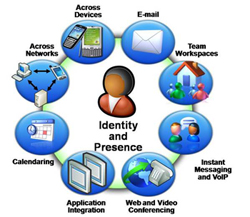From e-mail to Unified Communications, from an idea to a reality!! (1/3)
The following note -a series of 3- has the intent of providing my definition of MS Hosted UC as an offering and the foundation to build up a commercial model around it. Let's start.
Overview
In a service environment, people need to collaborate in order to provide an outstanding customer experience based on the fast, efficient provision of accurate information. A growing number of organizations are adopting Unified Communications (UC), which integrates email, telephony, instant messaging, voicemail and web conferencing in a single system.
“The cloud” is a friendly way of describing web-based services that are hosted outside of an organization. When customers use cloud-based services, their IT infrastructure resides off their property (off-premises), and is maintained by a third party (hosted), instead of residing on a server at their home or business (on-premises) that they maintain. Many services they use every day are a part of the cloud— everything from web-based email to mobile banking and online photo storage. Because this information is located online or “in the cloud,” they can access it virtually anywhere, from a PC, tablet, mobile phone, or other device with an Internet connection.
What does it mean to "move to the cloud"?
A move to the cloud can involve transferring or replacing some or all of the office-based or home-based software, storage, or infrastructure systems with web-based services. For instance, if a customer uses disparate onsite or online servers and services for file sharing and storage, email communication, web conferencing, or other business productivity needs, such organization could choose to transfer some or their entire IT infrastructure to the cloud or replace it with cloud-based services in order to improve data organization and collaboration.
Hosted Unified Communications consolidates many business productivity services into a single cloud-based solution that a customer can choose to run in a way that works best for their business: on-premises, as a hosted service, or as a combination of on-premises and a hosted service. This type of offer also works well with most current versions of Office or comes with the latest version, and it provides business-class email, file sharing, conferencing, and much more.
Moving to the cloud allows small and large enterprises to take advantage of subscription-based software as a service (SaaS) products. Instead of installing software on each computer in their organization, keeping them all updated, and buying new versions of the product, they can buy a subscription to a SaaS product and be assured that they always have the latest features and capabilities of the software package, with no maintenance required on their part, for a low monthly fee. Hosted UC is an example of SaaS.
Unified Communications
Unified Communications is a set of technologies that allows everyone within the organization to communicate in an easy and effective way. Unified Communications consist of many technologies which enable a corporate employee to be able to communicate in a very efficient way; these technologies include email, voice mail, instant messaging, presence information, Audio/Video conferencing, IP Telephony and Voice Mail.
Why Unified Communications?
Through the years, communication between people was the most important aspect of any business. Communicating within the organization, with customers and partners ensures the business flow and keeps everyone in sync. With the growth of businesses to regional and even global, more cost and time effective ways to communicate became an essential need. Including presence and IM with the ability to share information without needing to go through multiple systems is becoming a must.
Unified communications saves a lot of time when it comes to interacting with people, saving few minutes a day results in saving a lot of time through the year which can be used to achieve more and be more productive. In addition to the superior mobility that allows everyone to be able to communicate from almost everywhere.
As a service provider, your customers can benefit from capabilities like Enterprise Content Management, Collaboration, Rich-communications, Business Intelligence, and Enterprise Search on a subscription-based model that otherwise, it’ll be challenging for them to embrace as they might not have the right infrastructure to support and enable such services.
Why Collaboration?
Easing "collaboration" via the Web has lately been a popular theme for those seeking greater enterprise flexibility and resilience. We hear of collaborative teams, collaborative communities and collaborative commerce. The "c" word is used to describe everything from strategic alliances to internal and external partnerships. The concept of collaboration has become so diffuse that users have found it difficult to fit solutions to collaborative requirements. What’s
needed is a good working definition of collaboration that characterizes its variants, so that users will find it easier to select collaborative offerings that best fit their needs.
Literally, to collaborate means co-working or "working together." We offer a more-precise definition: "Collaboration is the process of working together toward a common purpose or goal in which the participants are committed and interdependent, with individual and collective accountability for the results of the collaboration, and each of the participants shares a common benefit."
The Four Pillars of Collaboration
- The participants have embraced a common purpose.
- Participants are committed to achieving specific goals and objectives supporting that common purpose.
- Participants are interdependent because they rely on each other’s roles, talents, resources, expertise, knowledge and other contributions necessary to achieve the specific goals and objectives.
- Participants are individually and collectively accountable for the results of the collaboration, yet share a common benefit.
